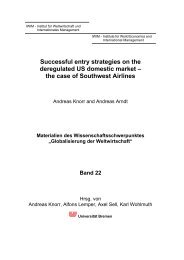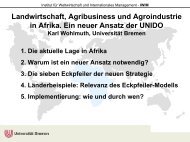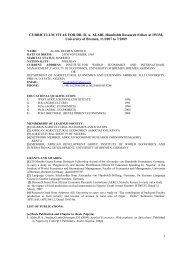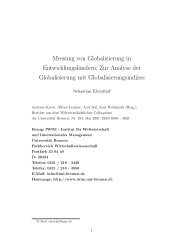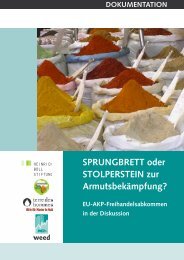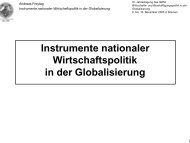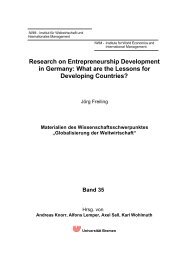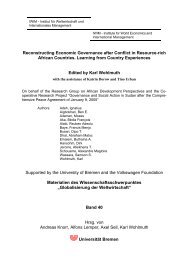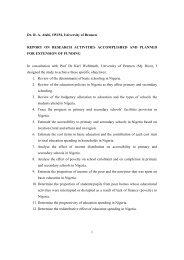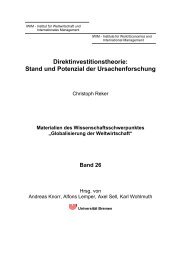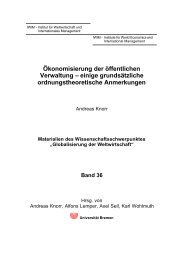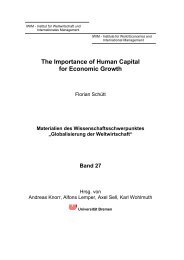Sectoral Analysis of Impact of Foreign Aid in Nigeria - Institute for ...
Sectoral Analysis of Impact of Foreign Aid in Nigeria - Institute for ...
Sectoral Analysis of Impact of Foreign Aid in Nigeria - Institute for ...
You also want an ePaper? Increase the reach of your titles
YUMPU automatically turns print PDFs into web optimized ePapers that Google loves.
3<br />
the effectiveness <strong>of</strong> the aid fund to justify the need <strong>for</strong> more aid. Nevertheless, <strong>for</strong> economic<br />
justification <strong>for</strong> additional aid, there is need <strong>for</strong> empirical <strong>in</strong>vestigation on the impact <strong>of</strong> the<br />
aid on the <strong>in</strong>dividual country at the economic sector level, especially us<strong>in</strong>g dynamic<br />
estimation method 4 , tak<strong>in</strong>g <strong>in</strong>to account the stochastic and dynamic nature <strong>of</strong> the economic<br />
agents <strong>in</strong>volved <strong>in</strong> <strong>for</strong>eign aid adm<strong>in</strong>istration. This study will be relevant to the aid recipient<br />
countries <strong>in</strong> improv<strong>in</strong>g their economic growth and productivity; it will also be useful to donor<br />
countries to gauge the effectiveness <strong>of</strong> their fund <strong>in</strong> assist<strong>in</strong>g <strong>Nigeria</strong>, which is the second<br />
most important economy <strong>in</strong> Africa and largest <strong>for</strong>eign aid recipient <strong>in</strong> Africa (Odusanya et al,<br />
2011).<br />
The sectoral analysis <strong>of</strong> impact <strong>of</strong> aid <strong>in</strong> <strong>Nigeria</strong> is important because <strong>for</strong>eign aid may<br />
have differentiated impacts at the sector levels. As <strong>in</strong>dicated <strong>in</strong> Table 1, the impact <strong>of</strong> aid <strong>in</strong><br />
<strong>Nigeria</strong> that used more than 66% <strong>of</strong> ODA <strong>for</strong> debt servic<strong>in</strong>g may be different from country<br />
like Ghana that used only 7.5% <strong>for</strong> debt service and country like South Africa that has no<br />
debt to service. The impact <strong>of</strong> aid on m<strong>in</strong><strong>in</strong>g sector <strong>in</strong> <strong>Nigeria</strong> which has only about 9% <strong>of</strong> aid<br />
allocation may be lower than the impact <strong>of</strong> aid on m<strong>in</strong><strong>in</strong>g <strong>in</strong> South Africa which has more<br />
than 99% <strong>of</strong> the allocation as reveals <strong>in</strong> Table 2. This justifies country specific study <strong>of</strong><br />
impact <strong>of</strong> <strong>for</strong>eign aid <strong>in</strong>stead <strong>of</strong> common cross country studies. The sectoral allocation <strong>of</strong> aid<br />
<strong>in</strong> <strong>Nigeria</strong> <strong>in</strong>dicates that adm<strong>in</strong>istration took the lion share <strong>of</strong> the aid (26.9%) at the detriment<br />
<strong>of</strong> productive sectors such as agriculture (5.4% aid allocation), energy and m<strong>in</strong><strong>in</strong>g (9.4% aid<br />
allocation), <strong>in</strong>dustry and trade (1.9% aid allocation) and transportation (6.8% aid allocation).<br />
The sectoral imbalance <strong>in</strong> aid allocation will have differentiated results on the impact <strong>of</strong><br />
<strong>for</strong>eign aid <strong>in</strong> <strong>Nigeria</strong>n economy. This type <strong>of</strong> f<strong>in</strong>anc<strong>in</strong>g arrangement will def<strong>in</strong>itely <strong>in</strong>fluence<br />
the impact <strong>of</strong> the aid on the economy and at the sector level, with a prior expectation that<br />
sector with highest aid allocation will be most affected. It is noteworthy that the impact <strong>of</strong><br />
<strong>for</strong>eign aid at the t sectoral level has not been given consideration <strong>in</strong> analysis <strong>of</strong> impact <strong>of</strong><br />
<strong>for</strong>eign aid <strong>in</strong> <strong>Nigeria</strong> and Africa at large. There<strong>for</strong>e, this study will not only answer the<br />
question <strong>of</strong> the impact <strong>of</strong> aid <strong>in</strong> <strong>Nigeria</strong>, it will also answer the question <strong>of</strong> which <strong>of</strong> the<br />
sectors is the impact has been most significant.<br />
4 Accord<strong>in</strong>g to Durbarry et al (1998), econometric aid-growth literature has been criticized on several grounds:<br />
sample size and composition, data quality, econometric technique and specification. The dynamic specification<br />
proposed <strong>for</strong> this study will take care <strong>of</strong> weakness associated with econometric techniques employed <strong>in</strong> the past<br />
aid- growth literature.



